The Zittau narrow gauge network
The direct train from Rostock via Berlin to Dresden was canceled without prior announcement. Like the other passengers waiting on the platform in Rostock I watched the information panel. It was the scheduled time of departure but there was no train. 20 min later the train suddenly disappeared from the panel and was replaced by another one in a different direction. It disappeared from the panel just a minute before the departure of a later train which would have allowed an alternative route to Berlin. A quick look into the app of Deutsche Bahn suddenly confirmed that the stop in Rostock was canceled. No reasons given.
New double deck IC train in Rostock arriving from Berlin. Instead of going back it disappeared
The next train left two hours later. It is a brand-new double deck IC. So brand-new that the staff does not know how to operate the coffee machines in the two snack points which replace the former bistro or restaurant. Even when they are in working order, their offer is limited. I unpack my own picnick and thermos can with tea and look at the flooded landscape outside. It has rained excessively in Eastern Germany for weeks, maybe month. Trees stand forlorn in endless expanses of water. The poor farmers. Most of the winter crop will be lost. The many industrial ruins along the route are increasingly hidden by sounds barriers as high as the train. The traveler can be glad that they also hide the depressing ugliness of German suburbia.
Changing trains in the station of Dresden Neustadt, a real cathedral of the great times of railways
After 4 hours the train moves into the majestic station of Dresden Neustadt. To go to Zittau I have to change here for a train to Görlitz, then change again in Bischofswerda. A long train of several new two car Diesel units moves in. Nobody bothers to tell people on the platform that a part of the train will only run to Bischofswerda and not all the way to Görlitz. I guess the train is full of junk food munching locals. I guess they all know.
Another changeover in the station of Bischofswerda
In Bischofswerda they rebuilt the platform. In fact they are busy installing a lift. Why it has to take more than one year, until 2025, to install a lift, is a miracle for While they are busy the underpass under the tracks is closed. People have to cross on a level crossing. It is one guy’s full time occupation to operate a barrier with red light across the tracks each time a train is about to pass or arrive. I am afraid the renovation will also be the end of the historic platform roof and shelters.
Heavily guarded temporary track crossing in Bischofswerda
Darkness spreads a merciful blanket over sights of abandon and neglect visible from the train window. Not a single station building at the stops of the one hour train journey between Bischofswerda and Zittau is renovated or in use. The windows and doors are boarded up, the walls covered in graffiti.
Two abandoned stations on the route from Bischofswerda to Zittau
The station in Zittau, built in 1959 is renovated. With the expansion of the railway network, Zittau received this modern train station. Unfortunately, Deutsche Bahn is not able to promote the beautiful building accordingly. Although the rail connections to Zittau and the bus and narrow-gauge station in front of the train station are well used, they have not even managed to attract permanent tenants to a kiosk or snack stand in the station. The Zittau train station is still a shining example compared to the graffiti-covered, abandoned and boarded-up stations on the lines that are supposed to bring trains to Zittau.
Hauptbahnhof Zittau. The narrow gauge line leaves from the square in front of the station
Zittau used to be an important railway junction. Already in 1848 the city was connected to the Saxon railway network to the west. An expansion to the south was finally carried out after initially being prevented by the k. u.k. Austro-Hungarian government. In 1859 a railway line to Liberec in Bohemia was opened. For this purpose, an impressive viaduct was built over the Neisse. At a length of 745 m, this bridge with 39 arches spans the Neisse Valley. It is one of the oldest and still longest stone railway bridges in Germany.
The 745 m long viaduct over the Neisse from 1859
Due to the lowering of the groundwater caused by the neighboring Polish open-cast lignite mine in Turów, the viaduct sank evenly by eight centimeters over its entire length between 1990 and 2002. It must therefore be constantly monitored. Nevertheless, the bridge can be passed at a speed of 90 km/h. It speaks for the quality of the builders back then that a bridge that was designed for much lighter trains still meets modern requirements today, while comparable modern bridges are often dilapidated after just a few decades.
Narrow gauge train to Oybin under the Neisse Viaduct in Zittau
Another line was built from Zittau to Görlitz and via the Czech town of Varnsdorf to Seifhennersdorf. After World War II, Zittau suddenly had a border to two states. While there was still a border with Czechoslovakia to the south and west, after the Second World War the Neisse suddenly became the border with Poland. In contrast to the West, the borders in the Warsaw Pact were by no means permeable. It was only after many years that there was relief in border traffic with Poland and Czechoslovakia, which was immediately reversed at the time of the Prague Spring.
Today the train travels via the Neisse viaduct to Poland. But it doesn't stop there. It passes only a few kilometers to the Polish border with the Czech Republic. The next stop is in Hradec nad Nisou in Czeck Republic. Conversely, the German train to Seifhennersdorf passes through the Czech Republic in Varnsdorf without stopping there. And the train to Görlitz crosses the German-Polish border several times. When he actually runs. In the town of Zittau proper, Poland is on the other side of the river. And if you walk a few minutes south from the Zittau Süd train station on the narrow-gauge railway, you will find yourself in the Czech Republic.
Railbus which used to roam the branch lines around Zittau
To accommodate the motive power necessary for all these railway lines a depot with turntable and shed was built where the locomotives were parked and maintained. The facilities are still there. A roundhouse in which the machines were located was accessible via a turntable. It is in ruins. The roof is collapsed. Inside you can still see historic vehicles. The others are now parked outside, where they are even more exposed to the weather and vandals. The entire complex, together with the narrow-gauge railway and the historic train station, in which a second rusty turntable on the platform is slowly being overgrown, would be an ideal location for a museum.
Little turntable in the station of Zittau
In order to connect more remote areas, additionally narrow-gauge railways were built in Saxony. As early as 1884, one of these railways was built from Zittau to Hermsdorf in the east. In 1890 another railway was built towards the Zittau Mountains. While the line to Hermsdorf was interrupted by the border after 1945 and later disappeared in the pit of a huge coal mine, the line to Oybin and Jonsdorf is still operating.
Steam train in the mountains close to Oybin
The narrow gauge railway line runs in a wide arc around the old town. Therefore it has to cross the main line on an intersection of narrow gauge and standard gauge, which is now unique in Germany. A little further on, the train passes under the large Neisse bridge again.
Crossing of the narrow gauge railway with the standard gauge main line to Liberec
Train under the bridge across the Neisse
Crossing bridges across the river Mandau for railway and street
There are other unusual features to this railway line. In the south of Zittau the railway crosses the Mandau River. In the middle of this bridge, the street on its own bridge is also crossed.
Bahnhof Zittau Vorstadt
A little further on, at the Zittau Vorstadt narrow-gauge railway station, you can still see what importance the railway had for the city. Unusually for a narrow-gauge railway, there even are passenger underpasses that were intended to bring passengers safely to the platform. Nobody uses them anymore today. A footpath has been created as access for passengers.
Arrival of trains at the station of Zittau Vorstadt
A freight train is exhibited in the station. The standard-gauge freight wagons were transported on so-called Rollwagen. The remains of the tracks on which the freight wagons were towed to the foundry behind it, which is still in operation, can still be seen in the pavement. Today, not only is there no longer any freight traffic: on the contrary, the narrow-gauge railway vehicles, which were previously loaded onto a standard-gauge wagon to be brought to the regular inspections using a ramp, now have to be brought to the examination workshop by road.
Standard gauge goods wagon on a Rollwagen for transport on the Schnalspurbahn
The times of freight trains are gone. Here a display of an entirely narrow gauge freight train
What was also unusual almost worldwide was that this narrow-gauge railway had double tracks from here to Bertsdorf. In Bertsdorf the railway branches into two short sections to the health resorts of Oybin and Jonsdorf. There was so much excursion traffic into the mountains that even electrification of the railway was suggested.
Steam engine taking water in Bertsdorf
The pillars of the bridge which swings in a wide arch over the village of Olbersdorf in the valley, show clearly that the route was much wider here. This space on the pillars held the second track .
The wide pillars of the bridge above Olbersdorf were laid out for double track
To take a photo of the train on the bridge I have to wait below the bridge between the houses of the village. Many are dilapidated or abandoned, some have already been demolished. But others are also in the process of renovation. Even though everyone is very friendly, I feel like I'm being watched. A loiterer with a camera. But nobody says anything. Things would have been different before 1990. You could have positioned yourself only briefly under the bridge just before the train passed by. And have disappeared quickly before the transport police arrived and arrested the Westerner who wanted to spy on the GDR's strategically important, modern railway technology.
The bridge above Olbersdorf
The busy traffic on the route has also led to signal boxes with remote-controlled switches being installed in Bertsdorf, Zittau Süd and Jonsdorf. Today only the signal box in Bertsdorf is still in operation.
Departure of a train in Bertsdorf. The signal box is on the left
In Oybin and Jonsdorf, the conductor has to change the switches by hand while moving the locomotive to the other end of the train. This requires travelling a long distance to the end of the station, which are covered on the steps of the locomotive.
The terminus of the line at Jonsdorf
The contrast to the deplorable conditions of Deutsche Bahn's railway facilities cannot be greater. On the narrow-gauge line operated by SOEG, it is striking how lovingly everything is maintained and the service offered. There is a manned ticket office in Zittau. There is a dining car on the train, in which most of the passengers spend the almost hour-long journey to the little resort village of Oybin.
Historic waiting room and ticket office in Bertsdorf
The Bertsdorf train station has been renovated and you can rent holiday apartments there. In the summer, wagons are also parked at Oybin train station and can be rented as holiday apartments. The waiting rooms in the train stations are open so that travelers can protect themselves from the cold wind. The toilet buildings that used to be available at every train station in Germany are open, clean and free. In Bertsdorf, the interior of the original GDR ticket office has been preserved. In Oybin you can warm up in the station restaurant until the train leaves. The platform roofs have also been lovingly restored. This includes a unique gable roof in Zittau and Bertsdorf that is intended to protect passengers when crossing the tracks to the platform.
The covered access to the platform in Bertsdorf
One of the attractions of the Zittau narrow-gauge network is that two trains run here every day, and sometimes three in summer. In addition to a train that runs back and forth between Zittau and Oybin four times a day, there is a second train that, after traveling from Zittau to Bertsdorf, runs back and forth between Bertsdorf - Oybin and Jonsdorf as a "mountain shuttle". But when I get to the train station in Zittau in the morning to take the steam train to Oybin, a diesel locomotive is waiting at the platform. The first train and the mountain shuttle are not run by steam. I let the diesel train leave and wait for the steam train.
Before departure of the train in Zittau
There are a lot of industrial ruins in the area surrounding the city of Zittau. There was an open-pit coal mining area near the Zittau Vorstadt train station, of which Lake Olbersdorf bears witness today. If the reunification of Germany hadn't come just in time in 1989, this mining would probably have meant the end of the railway, as they wanted to expand the open-pit mining to the west to where the railway line runs. After reunification, the uneconomic mining in this area was stopped. All these enterprises brought freight traffic for the narrow gauge railway
There is also an abandoned industrial plant at the Olberndorf-Niederdorf train station, where the train only stops when necessary. The station building was apparently sold to a private owner. It is the only one on the entire route in a deplorable condition.
The ruins of the former Phänomen company, later VEB Robur
Behind the train station, on the way into the city, lie the ruins of a large abandoned industrial area. With industrialization, Zittau became, in addition to the still flourishing textile industry, also the headquarters of the Phänomen Bicycle Works. Thep company later also manufactured motorcycles, cars and commercial vehicles. In addition to the coal open pit mining, there were also metal processing factories. Due to the border location - after all, the Imperial German Empire had waged war against the Emperor of Austria in 1866 - it was seen as necessary to create a barracks district in 1869. A use is still being sought for these buildings today.
Former barracks
The narrow gauge line network in Zittau owes it’s survival to the popularity of the Zittau mountains as a tourist destination. The jumble of sandstone cliffs, up to 792 m high, is the smallest mountain range in Germany. Numerous wildly romantic rock formations ensured that the area was visited by tourists from an early age. In the 14th century emperor Charles IV was probably the first. He had ther former robbers hideout Oybin expanded into a retirement home for himself. The complex occupies the entire area of the plateau of a 500 m high sandstone cliff above the little resort village of Oybin.
The sandstone rock with the Oybin monastery and castle
Charles IV had not only built the castle and palace up here. He also brought monks of the Order of the Cölestines with him from Prague. Construction began immediately on a monastery for the monks, including a Gothic cathedral. Artisans who were also responsible for the construction of St. Vitus Cathedral in Prague played a key role in the construction. The southern wall of the cathedral was carved from the Oybin sandstone rock. On the north side there was a two-story cloister and a library. The monks who lived here were artists renowned throughout the empire in writing and copying scripts, calligraphy and bookbinding.
Arrival in Oybin station
Climb to the castle
Entrance gate to Oybin castle
The ruins of the monastery's cathedral
But the Reformation prevailed. The monastery was dissolved. In 1560 the library and church treasures were brought back to Prague. When lightning struck in 1577 and caused a fire the castle probably already was no longer inhabited. However, there must have been a powder magazine that blew up along with part of the building due to the fire. Further destruction occurred when the north wall of the monastery library fell into the depths after a rock fall.
View over the ruins of the monastery church towards the Zittau Mountains
After that, the castle was abandoned and was used as a quarry for construction work by the residents of the area. In the 18th century the area was discovered by Romantic artists. Hikes in the Riesengebirge became popular. Painters such as Johann Alexander Thiele, Adrian Zingg, Johann Philipp, Veith Carl Gustav Carus, Ernst Ferdinand Oehme, Carl Blechen and Adrian Ludwig Richter used the Oybin as a motif. Its most famous representative was Caspar David Friedrich, who stopped here in 1810 on a hike through the mountains.
From the vantage point of the castle you can overlook the valley and watch the narrow gauge trains climbing towards the little station of Oybin. There is one train every hour here, alternating from Zittau by steam engine and – unfortunately - from Jonsdorf by Diesel.
The railway has to deal with a shortage of staff. What was a dream for every boy in my youth, to become a train driver and in particular one driving a steam engine, is now seen as an excessively tough job. It also does not fit into the present mentality of hire and fire….. operating a steam engine requires knowledge and care. The driver has to check the many moving parts constantly to avoid overheated bearings. The job of the fireman is not only strenuous, but he also has to take care that there is sufficient pressure in the boiler for the strenuous climb into the mountains without wasting coal and his own energy.
Steam train near Teufelsmühle stop on its way to Oybin
After the last train has reached its destination, work is not finished. The engine has to be serviced, oiled and greased again, water and coal supply refilled and ashed and soot removed from the ash pan and smoke chamber. Everything a tiring and dirty business.
A steam goes to rest ... The cinders are removed from the smoke chamber and the water supply refilled
In the background the ruins of the roundhouse of the mainline railway
Motive power reserve in the narrow gauge shed in Zittau
When I arrive at the train station for my trip back, it turns out that there is no train on the route to Görlitz, which crosses the Polish border several times. They stole the communication cables. A man waiting with me for the replacement bus tells me that this is the third time. The thieves sell the copper. Since the railway line is owned by Deutsche Bahn but is on Polish territory, it is a kind of legal-free zone. Apparently the railways of the modern industrial state of Germany have not yet heard of mobile communication. I have to take the replacement bus
More about Zittau and its history can be found here:
The city hall with its typical campanile
Neustadt
Sources:
W. Meereis, Besuch bei den sächsischen Schmalspurbahnen", EK Verlag, Solingen 1972
View of the campanile of the city hall













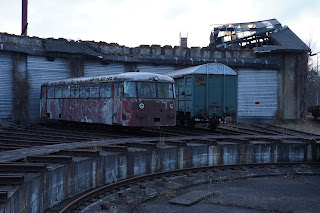












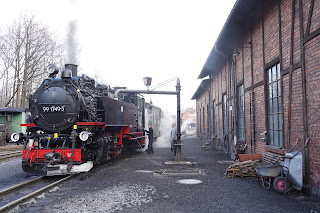




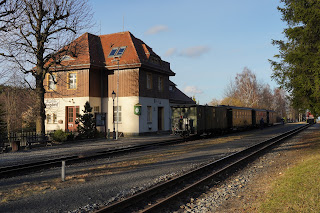

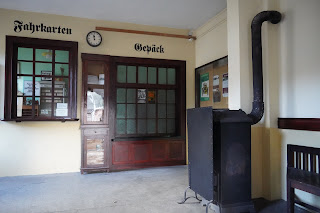




















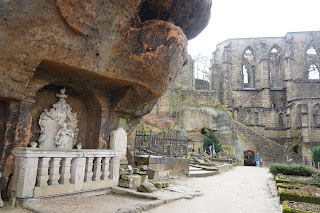











No comments:
Post a Comment